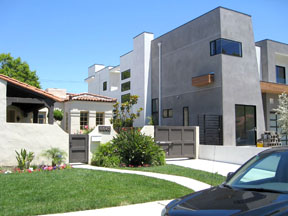Amended McMansion law has ‘sound foundation’

MCMANSION in Miracle Mile next to a historic home. Courtesy miraclemilela.com
A new and improved anti-McMansion ordinance passed last month by the City Council will make major improvements in neighborhoods near and far — throughout Los Angeles, according to advocates for the measure.
“Great news!” is how the Los Angeles Conservancy called the “final push to curb mansionization and tear downs.”
“It was such a grass roots movement,” said Bob Eisele, vice president of the La Brea-Hancock Homeowners Assoc., which, while a relatively small neighborhood group, had a large impact on the ordinance’s passage.
Early on, a door-to-door petition received a 66 percent approval to move forward. “That is a huge amount,” said Eisele, who was encouraged to plow ahead, leading to last month’s victory.
The improvements to the Baseline Mansionization Ordinance (BMO) include a “tighter ratio of house size to lot size, bigger setbacks, and elimination of most bonuses and exemptions,” according to Shelley Wagers of nomoremcmansionsinlosangeles.com.
“Big boxes that loom over their neighbors will be replaced by comfortable, spacious homes that fit the scale and character of their neighborhoods,” Wager said.
Ordinance approved
The City Council unanimously approved the revised BMO March 1, and it went into effect March 17.
Originally passed in 2008 in response to a proliferation of out-of-scale buildings in residential neighborhoods throughout the city, loopholes in the original ordinance allowed developers to continue to build homes too large for their lots, critics complained, and city officials directed the Dept. of City Planning to amend the ordinance.
Some provisions in the original ordinance — such as design bonuses — actually encouraged the kind of out-of-scale homes that the ordinance was designed to prevent, according to the Los Angeles Conservancy website.
Until last month, a developer or homeowner could build more than 4,300 square feet on a 6,000 square-foot lot.
Not any more.
“The limit (for the same 6,000 square-foot lot) will be a little over 3,000 square feet, depending on garage configuration,” Wagers said.
A 200 square-foot exemption is available for garages built in the front of a lot and a 400 square-foot exemption remains for garages in the rear.
The residential Floor Area Ratio (FAR) for single-family properties is restricted to 45 percent, which is down from 50 percent for properties less than 7,500 square feet. Properties 7,500 square feet or larger were previously restricted to 45 percent, and the new regulations do not change that.
‘Variation’ zones
In addition, several neighborhoods received tailor-made zoning, called R-1 Variation Zones, created as part of the City Planning Dept.’s Neighborhood Conservation Initiative and consolidated into the BMO.
Both Larchmont and LaBrea–Hancock R-1 Variation Zones will include an RG Rear Detached Garage Supplemental Use District, meaning: “All new construction must have a rear garage,” said Barbara Savage, president of the La Brea–Hancock Homeowners Assoc.
“Our new R1R3-RG zone requires rear-massing if you build a second story (it can only be in the back of the house, not the front), allows only detached rear garages, and establishes a FAR of .43 for most of our lots,” said Eisele.
(R1R3 requires the rear-massing and is one of four variations of R1R, according to the ordinance.)
“Architectural style is not dictated by the new zone,” said Eisele, who lives in a 1924 Spanish Colonial Revival style home with a Batchelder tile fireplace — typical of those in the La Brea-Hancock area’s 12-blocks, a short walk to Wilshire Blvd., between La Brea and Highland avenues.
While the area is relatively small, “we had more attendees at hearings than most other neighborhoods,” Eisele said of the trips to City Hall, plus letters written to council members.
Their dogged determination made an impact as did standing unanimous, said Diana Eisele. “It’s the staying power… I think our neighborhood started a citywide movement.”
The anti-mansionization movement actually began in Beverly Grove and led to the original ordinance passage in 2008. After their success, “other neighborhoods said we want that, too,” added Bob.
Bob and Diana credited La Brea-Hancock president Barbara Savage and secretary Cathy Roberts.
Half a loaf
While community activists worked hard for a prohibition of front-facing attached garages, the City Council did not support the request, “and we had to settle for half a loaf,” said Wagers, of Beverly Grove.
“The amended ordinances are not perfect, but they go a long way to honor the scale and character of L.A.’s residential neighborhoods and put a stop to McMansions that price so many families out of the market. And they provide a sound foundation for variation zones that offer additional options and set the tone for much-needed reform to follow.”
She credited City Councilman Paul Koretz, who spearheaded the drive, putting mansionization reform “on the table and rode herd on it for almost three years. These amendments are a major accomplishment, and he deserves a ton of credit.”
Category: News







